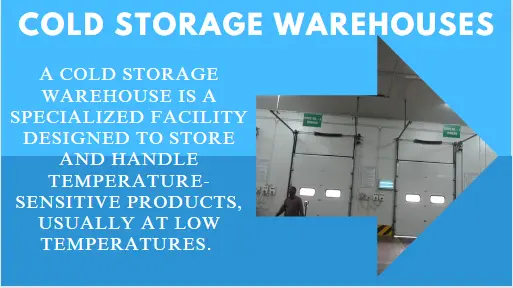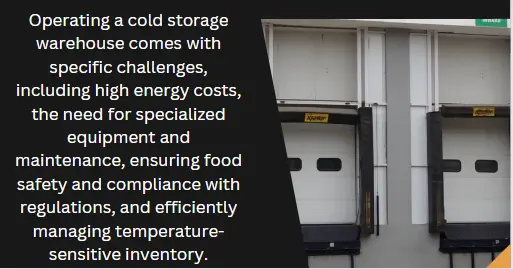Cold storage warehouses are specialized facilities designed to maintain controlled low temperatures, preserving a wide range of perishable goods, including food, pharmaceuticals, and chemicals. These vital storage facilities ensure the freshness and safety of products throughout the supply chain. In this comprehensive document, we will explore the world of cold storage warehouses, their functions, features, technology integration, and their indispensable role in the preservation and distribution of temperature-sensitive goods.
- 1. Introduction
- 2. Need for cold storage warehouses
- 3. Functions of cold storage warehouses
- 4. Features of cold storage warehouses
- 5. Technology in cold storage warehouses
- 6. Challenges faced by cold storage warehouses
- 7. Modern Relevance of Cold Storage Warehouses
- 8. Conclusion
- Frequently Asked Questions:
- What is a cold storage warehouse?
- What types of products are stored in cold storage warehouses?
- How are cold storage warehouses different from regular warehouses?
- What is the temperature limit in cold storage warehouses?
- What are the major factors affecting the operation of a cold storage warehouse?
- How are products stored and organized in a cold storage warehouse?
- What are the challenges in operating a cold storage warehouse?
- What are the benefits of using a cold storage warehouse?
- How do cold storage warehouses contribute to food safety?
- What are some regulations and standards that cold storage warehouses must follow?
1. Introduction
Cold storage warehouses, often referred to as refrigerated warehouses or cold chain storage, are essential components of the global supply chain. They play a vital role in preserving the quality, safety, and shelf life of perishable goods, ensuring that these products reach consumers in optimal condition. From fresh produce and frozen foods to vaccines and pharmaceuticals, cold storage warehouses play a vital role in maintaining the integrity of temperature-sensitive commodities.
2. Need for cold storage warehouses
The need for cold storage warehouses is driven by several factors:
2.1. Perishable goods
Many products, such as fresh fruits, vegetables, dairy products, meat, seafood, and baked goods, have a limited shelf life due to their proneness to spoilage, bacterial growth, or enzymatic reactions. Cold storage warehouses help in increasing the feasibility of these products.
2.2. Food security
Maintaining specific temperature ranges is important for food safety. Cold storage warehouses reduce the risk of bacterial adulteration and foodborne illnesses, ensuring consumers receive safe and nutritious products.
2.3. Medicines
Pharmaceutical products, including vaccines and drugs, often require controlled temperatures to maintain their potency and effectiveness. Cold storage warehouses are essential for the pharmaceutical industry to ensure product quality.
2.4. Seasonal variability
Seasonal variations in production may result in fluctuations in supply. Cold storage warehouses help balance the availability of products throughout the year, allowing consumers to enjoy seasonal items throughout the year.
2.5. Global supply chain
With the globalization of supply chains, products are often transported over long distances. Cold storage warehouses ensure that goods remain fresh and maintain their market value during transit and storage.

3. Functions of cold storage warehouses
Cold storage warehouses perform several important functions within the supply chain:
3.1. Temperature control
The primary function of cold storage warehouses is to maintain the specific temperature range required for the products they store. These temperatures can range from below zero for frozen items to slightly above zero for chilled items.
3.2. Inventory management
Cold storage warehouses use advanced inventory management systems to track and manage temperature-sensitive products. This includes monitoring expiration dates, lot numbers, and product rotation to prevent spoilage.
3.3. Order Complete
These facilities fulfill orders by picking, packing, and shipping temperature-sensitive products. Accuracy is important to ensure that customers receive products in the best condition.
3.4. Cross-docking
Cross-docking is an essential process in cold storage warehouses. Incoming products are immediately transferred from the receiving area to the shipping area, reducing time spent storing products and reducing temperature fluctuations.
3.5. Quality control
Quality control measures, such as regular inspections and testing, are taken to ensure that products meet safety and quality standards. Any product that does not meet these criteria is removed from the inventory.
4. Features of cold storage warehouses
Cold storage warehouses exhibit several key features:
4.1. Temperate zones
These facilities have different temperature zones or chambers to accommodate products with different temperature requirements. For example, they may have frozen storage, chilled storage, and ambient temperature storage areas.
4.2. Insulation and climate control
Cold storage warehouses are highly insulated to prevent the exchange of heat with the outside environment. Climate control systems, including refrigeration and air conditioning, maintain the desired temperature.
4.3. Refrigeration units
Refrigeration units are important for cooling storage areas and ensuring consistent temperatures. These units may use different cooling agents, such as ammonia or Freon, depending on the facility’s design and environmental considerations.
4.4. Racking system
To optimize storage space, cold storage warehouses use specialized racking systems that allow efficient stacking and access to products. These systems are designed to maximize storage capacity while minimizing temperature fluctuations.
4.5. Safety measures
Security is paramount in cold storage warehouses to prevent unauthorized access and theft. Access control, surveillance cameras, and alarm systems are commonly employed.

5. Technology in cold storage warehouses
The integration of technology has significantly improved the efficiency and reliability of cold storage warehouses. Major technological advances include:
5.1. Warehouse Management System (WMS)
WMS software plays a vital role in managing inventory, orders, and temperature control in cold storage warehouses. It provides real-time visibility and control over operations.
5.2. Automated Content Management System
Automation, including conveyor systems and robotic palletizing, streamlines material handling and reduces manual labor. This helps maintain temperature consistency and increases order accuracy.
5.3. Temperature monitoring
A temperature monitoring system equipped with sensors and alarms ensures that storage conditions are maintained within the specified temperature range. Any deviation triggers alerts for immediate corrective action.
5.4. Cold chain visibility
Advanced tracking technologies like RFID and GPS provide real-time visibility of the location and temperature of products during transit. This visibility is especially important for temperature-sensitive pharmaceuticals and vaccines.
5.5. Data analysis
Data analytics tools are used to analyze warehouse performance, predict inventory requirements, and optimize operations. They provide insights for making informed decisions.
6. Challenges faced by cold storage warehouses
Cold storage warehouses face various challenges in their operations:
6.1. Energy expenditure
Maintaining low temperatures consumes a lot of energy. Energy efficiency measures and the use of eco-friendly refrigerators are being explored to reduce operating costs.
6.2. Equipment maintenance
Refrigeration units and cooling systems require regular maintenance to ensure that they function properly. Breakage can result in temperature fluctuations and product failure.
6.3. Cold chain broken
Maintaining cold chain integrity, especially during product transit, is a challenge. Temperature-sensitive products must remain within specified temperature ranges throughout the supply chain.
6.4. Food safety regulations
Tough food safety regulations require cold storage warehouses to maintain high standards of cleanliness and quality control to prevent contamination and foodborne illnesses.
6.5. Lack of space
As demand for cold storage space increases, finding suitable space and expanding existing facilities can be challenging. Space constraints can limit the capacity of cold storage warehouses.

7. Modern Relevance of Cold Storage Warehouses
Cold storage warehouses remain critically relevant in today’s global supply chain for several reasons:
7.1. Globalization of food supply
As consumers enjoy a diverse range of foods from around the world, the need for cold storage facilities to preserve and distribute these products has increased. Cold storage warehouses enable year-round availability of seasonal and international goods.
7.2. E-commerce and grocery delivery
The growth of e-commerce and online grocery delivery has increased the demand for cold storage. These features are essential to fulfill online orders for perishable goods.
7.3. Pharmaceutical supply chain
The pharmaceutical industry relies on cold storage warehouses to ensure that vaccines, medicines, and biologics remain effective and safe. The demand for temperature-controlled storage has intensified with the development of new vaccines and biopharmaceuticals.
7.4. Continuous practice
Cold storage warehouses are exploring sustainable practices, including energy-efficient refrigeration systems and eco-friendly refrigerants, to reduce their environmental impact.
7.5. Emergency response
Cold storage warehouses have become vital in emergency response situations such as disaster relief efforts and the distribution of vaccines during health crises.

8. Conclusion
Cold storage warehouses are crucial in the preservation and distribution of perishable goods, which play a vital role in the global supply chain. Their functions, features, and technology integration have evolved to meet the growing demand for temperature-sensitive products.
Ultimately, cold storage warehouses ensure the freshness, safety, and availability of a wide range of products from fresh food to life-saving medicines. As technology advances and global supply chains evolve, cold storage facilities will remain at the forefront of ensuring that temperature-sensitive commodities reach consumers in optimal condition, maintaining the quality and integrity of these vital products.
For Similar Topics Click Here
Frequently Asked Questions:
What is a cold storage warehouse?
A cold storage warehouse is a specialized facility designed to store and handle temperature-sensitive products, usually at low temperatures. These warehouses are equipped with refrigeration and freezing systems to maintain the desired temperature and humidity levels required for safe and extended storage of perishable food, pharmaceuticals, and other products that require keeping cool.
What types of products are stored in cold storage warehouses?
Cold storage warehouses are used for a wide range of temperature-sensitive products, including:
Frozen foods: such as meat, seafood, vegetables, and ready meals.
Fresh produce: Fruits, vegetables, and dairy products.
Pharmaceuticals: Vaccines, drugs, and biologics.
Floral Products: Cut flowers and plants.
Chemicals: Some chemicals require specific temperature controls.
Beverages: Cold and frozen beverages.
How are cold storage warehouses different from regular warehouses?
Cold storage warehouses differ from regular warehouses in that they are equipped with refrigeration and freezing systems to maintain low temperatures. They also have padding and air circulation systems that help prevent temperature fluctuations and ensure a consistently cool environment. Additionally, cold storage warehouses often have specialized handling equipment and storage solutions designed to accommodate the unique needs of temperature-sensitive products.
What is the temperature limit in cold storage warehouses?
The temperature range in cold storage warehouses can vary, but it generally falls into one of these ranges:
Refrigerated storage: Temperature is usually maintained between 32°F (0°C) and 45°F (7°C).
Frozen storage: Maintained at temperatures below 32°F (0°C). Different products may require different freezing temperatures.
What are the major factors affecting the operation of a cold storage warehouse?
Many factors can affect the operation of a cold storage warehouse, including:
Temperature Control: Maintaining the desired temperature range is important for product quality and safety.
Humidity Control: Some products require specific humidity levels to prevent drying or moisture damage.
Inventory Management: Efficient storage and recovery systems are essential to reduce product handling and maintain inventory accuracy.
Security: Cold storage warehouses often contain valuable or sensitive products, so security measures are important.
Energy Efficiency: These facilities can be energy-intensive, so energy-efficient systems are important for cost savings and environmental considerations.
How are products stored and organized in a cold storage warehouse?
Products are stored and organized in cold storage warehouses using a variety of methods, including:
Pallet racking: Products are stored on pallets, which are placed on a racking system. This is a common method for large quantities of goods.
Carton Flow Rack: Ideal for smaller items, carton flow racks use gravity to move products forward, ensuring FIFO (first-in-first-out) inventory management.
Bulk storage: Some items are stored in bulk on shelves or racks without individual packaging. Automated systems: Some warehouses use automated systems to optimize storage and recovery, such as robotic retrieval systems.
What are the challenges in operating a cold storage warehouse?
Operating a cold storage warehouse comes with specific challenges, including high energy costs, the need for specialized equipment and maintenance, ensuring food safety and compliance with regulations, and efficiently managing temperature-sensitive inventory.
What are the benefits of using a cold storage warehouse?
The benefits of using a cold storage warehouse include:
Extended shelf life: Products can be stored for longer periods without spoiling.
Seasonal flexibility: Allows storage of products out of season.
Efficient supply chain management: Ensures continuous supply of products to the market.
Improves product quality: Maintains freshness and quality of items. Waste Reduction: Reduces product damage and wastage.
How do cold storage warehouses contribute to food safety?
Cold storage warehouses play an important role in food safety by maintaining proper temperature and humidity levels to prevent the growth of pathogens and the worsening of food products. They help ensure that perishable foods remain safe for consumption throughout their entire supply chain journey, from production to consumption.
What are some regulations and standards that cold storage warehouses must follow?
Cold storage warehouses must comply with various regulations and standards, which may vary according to the location and type of products stored. Common standards include food safety (e.g., HACCP), temperature control, sanitation, and occupational safety.
